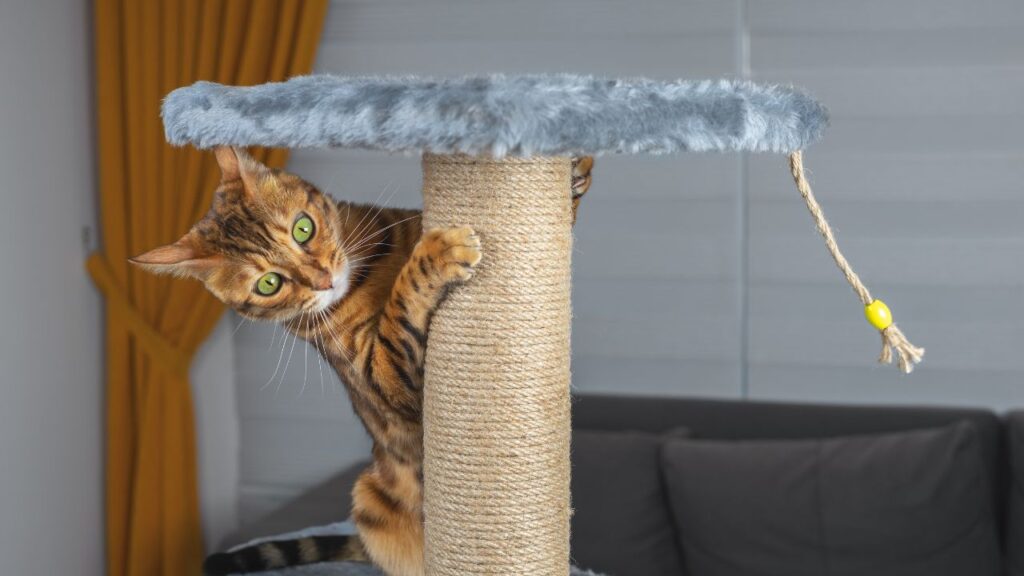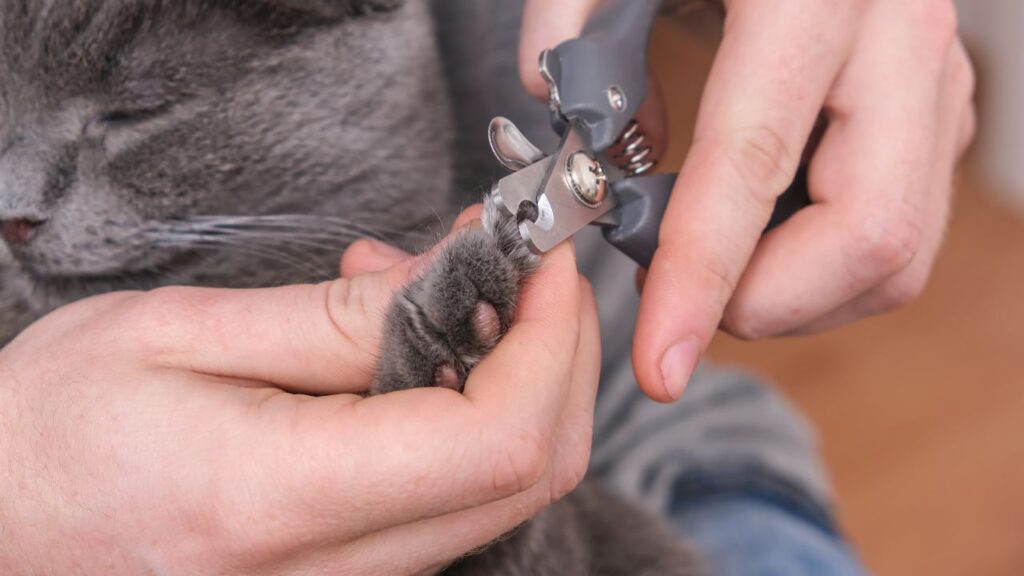Let’s face it: you love your cat, but sometimes they drive you crazy. Like when they dig their claws into your gorgeous leather sofa, leaving scratches and tears that seem to say, “I own this now.” You’ve tried to ignore it, maybe even hoped it would stop, but deep down, you know—you need to figure out how to stop a cat from scratching leather.
Don’t worry! You’re not alone. Many cat owners find themselves in this exact situation. But fear not—there are plenty of ways to redirect those sharp claws away from your precious leather. Whether your cat is a young kitten exploring the world or an adult with an established scratching habit, this guide will help you protect your furniture while keeping your cat happy. So, let’s dive in, shall we?
Contents
Why Do Cats Scratch Leather Furniture?
Before we go into full-on rescue mode, let’s take a minute to understand why your cat is scratching your leather in the first place. You might be thinking, “They must know better, right?” Well, not exactly.
Cats Scratch to Mark Territory
Cats are territorial creatures by nature. When they scratch, they’re not just sharpening their claws—they’re marking their space. Yep, those little scent glands in their paws are busy at work every time they scratch. To your cat, your leather couch could be seen as prime real estate that needs to be marked. It’s a bit like leaving a “Do Not Disturb” sign, but instead of words, it’s a clawed-up cushion.
Claw Maintenance and Stretching
But it’s not just about marking territory. Cats also scratch to maintain their claws. Think of it like a human going to the nail salon. Scratching helps your cat shed the outer layer of their claws, keeping them sharp and healthy. They’re not scratching because they hate your furniture—they’re just doing their feline thing.
Boredom or Stress
Sometimes, it’s less about instinct and more about frustration. Cats are curious creatures, and if they’re bored or stressed, they may channel that energy into scratching. If your cat’s scratching is excessive, it could be a sign they need more mental stimulation or a better outlet for their energy.
How to Stop a Cat from Scratching Leather: 7 Solutions
Alright, now that we’ve got the why covered, let’s talk about how to stop a cat from scratching leather. Because, let’s face it, there’s nothing worse than walking into your living room and finding fresh scratches on your favorite chair. Ready for some solutions?

1. Provide a Better Scratching Option
It sounds simple, but sometimes the best way to stop your cat from scratching leather is to give them something better to scratch. If your cat is attracted to your couch, it could be because they like the texture or the height. Try placing a scratching post or pad next to the leather furniture. Make sure it’s tall enough for them to fully stretch out.
Why It Works:
Cats love variety. A good scratching post provides an outlet for their natural instincts. The key is to make it irresistible—different textures, tall enough to stretch, and sturdy enough so it won’t tip over.
Pro Tip:
Don’t be shy—sprinkle some catnip on the scratching post. It’s like putting a giant “vacancy” sign in front of a five-star hotel for your cat. They’ll love it.
2. Use a Deterrent Spray
If your cat is still obsessed with your leather furniture, it’s time to bring out the big guns: cat deterrent sprays. These sprays have scents that are unpleasant to cats but completely safe for humans. They might not love the smell, but your cat will hate it.
Why It Works:
When your cat scratches an area that’s been sprayed, they’ll quickly associate that spot with something unpleasant. Over time, they’ll learn to avoid it.
Pro Tip:
Be sure to test the spray on a small area of the leather first. You don’t want to risk any discoloration or damage to the surface. And don’t overdo it with the spray—just a light mist is enough.
3. Cover the Furniture
Sometimes, the simplest solution is the best one. Covering your leather furniture with a slipcover, blanket, or throw can protect it from scratches. It’s not a permanent fix, but it’s a quick way to buy yourself some time while working on the other strategies.
Why It Works:
The physical barrier makes it harder for your cat to get a good grip on the leather. It’s also a temporary shield, which helps protect the furniture while you redirect your cat’s behavior.
Pro Tip:
If your cat’s determined, they might still try to scratch the cover, so make sure it’s secure. You can even use non-slip mats underneath to keep it from shifting.
4. Trim Your Cat’s Claws
Don’t worry, trimming your cat’s claws isn’t as scary as it sounds. While it won’t stop your cat from scratching entirely, it will help reduce the damage. After all, shorter claws mean less damage to your leather.

Why It Works:
Trimming your cat’s claws makes it less likely that they’ll tear through the leather when they scratch. It’s not a full solution, but it’s a good preventive measure.
Pro Tip:
If you’ve never trimmed your cat’s claws before, ask your vet or a professional groomer to show you how. Make sure you’re only trimming the sharp tips and not cutting too deep.
5. Use Sticky Paws or Double-Sided Tape
Sticky Paws or double-sided tape is a sneaky trick that might just work. Cats despise sticky surfaces, so placing tape on areas your cat likes to scratch can deter them.
Why It Works:
When your cat comes into contact with the sticky surface, they’ll quickly realize it’s not the ideal scratching spot. It’s an easy and effective way to train them out of their habit.
Pro Tip:
Only leave the tape on for a little while. It’s not a permanent solution, but it can help break the habit long enough for you to move on to other methods.
6. Redirect with Positive Reinforcement
Your cat might be scratching out of habit, and that’s where positive reinforcement comes into play. Every time your cat uses the scratching post instead of the couch, reward them with a treat, praise, or extra playtime.
Why It Works:
Cats respond well to rewards. By offering something positive when they scratch the right spot, you’re reinforcing good behavior and teaching them where to scratch.
Pro Tip:
Consistency is key! Make sure you reward your cat immediately after they use the scratching post so they can make the connection.
7. Offer More Mental Stimulation
Boredom and anxiety can cause your cat to act out. So, try giving your cat more things to do. New toys, cat trees, and interactive playtime can help burn off that excess energy.
Why It Works:
A mentally stimulated cat is a less likely scratcher. Providing alternative outlets for their energy will keep them from focusing on the furniture.
Pro Tip:
Rotate their toys to keep things fresh. A puzzle feeder or a laser pointer can help tire them out and keep them engaged.
Comparing Solutions to Stop Scratching
| Solution | Effectiveness | Best For |
|---|---|---|
| Scratching post | High | Cats who need an outlet for scratching |
| Deterrent spray | Medium to High | Persistent scratchers |
| Slipcovers or throw blankets | Medium | Temporary protection |
| Claw trimming | Medium | Reducing damage but not stopping behavior |
| Sticky Paws or tape | High | Quick behavior modification |
| Positive reinforcement | High | Cats who respond well to rewards |
| More mental stimulation | Medium to High | Bored or anxious cats |
FAQ: Common Questions
Q: What if my cat is scratching everything, not just the leather?
A: If your cat is scratching everything in sight, it could be a sign of stress or boredom. Try offering more toys, a cat tree, and extra playtime to keep them engaged.
Q: Will declawing my cat stop scratching?
A: Absolutely not. Declawing is inhumane and can cause lifelong pain and behavioral issues. Focus on positive methods like scratching posts and deterrent sprays.
Q: How often should I trim my cat’s claws?
A: It varies, but generally, trimming every 2-3 weeks is a good schedule. Keep an eye on their claws, and if they seem to be getting too sharp, it’s time for a trim.
Q: Do scratching posts really work?
A: Yes! But only if your cat actually uses them. Be patient and consistent, and you’ll likely see results. Make sure the scratching post is tall, sturdy, and covered with a material your cat enjoys.
Conclusion: Protect Your Leather (and Your Cat’s Happiness)
It can be frustrating when your cat scratches your leather furniture, but with the right approach, you can protect your precious pieces and keep your cat happy. Whether it’s providing a scratching post, using deterrent sprays, or just trimming those claws, there are plenty of ways to redirect your cat’s behavior.
Remember, scratching is a natural instinct for cats, so it’s not about punishing them—it’s about finding a solution that works for both you and your feline friend.

